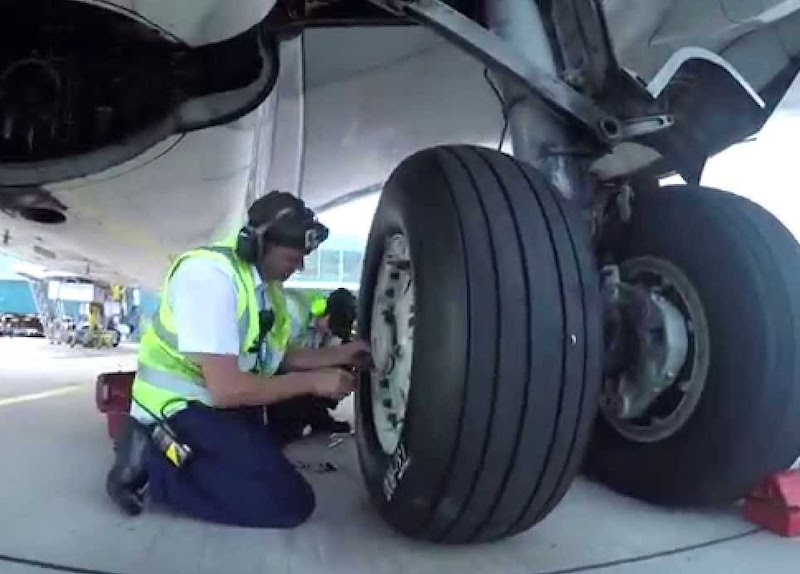Union-brawling Qantas chief Alan Joyce has capitulated to pay rises of up to 33% over five years in a deal struck with the Aircraft Engineers’ Association. Michael Sainsbury with the scoop.
Qantas’ return to profits has finally proven a boon for workers, some workers. Union-brawling chief executive Alan Joyce has quietly caved in to the Australian Licenced Aircraft Engineers’ Association (ALAEA), offering maintenance staff a juicy new pay deal that gives some of them pay increases of as much as 33% over seven years in an agreement that dates back to 2019.
Licensed aviation engineers are an increasingly rare breed both in Australia and worldwide. Their average age is 54 and the company has all but stopped training apprentices over the past 13 years.
Nevertheless, for those who remain, this is substantially above the standard offer of 9% over five years he has been telling the market he won’t budge on for Qantas staff. Unions have been pushing back against the broad offer which effectively lowers the real wages of the company’s staff by 10-15% as it charges towards a record half-year profit of up to $1.4 billion for the six months to December 31.
Qantas deals with multiple unions including the Australian Federation of Air Pilots, the ALAEA, the Transport Workers Union, the Flight Attendant’s Association of Australia (FAAA), the Transport Workers Union, the Australian Services Union (ASU) and the Australian and International Pilots Association (AIPA).
56 separate enterprise deals
The airline has been fighting unions on a number of fronts and has a bewildering 56 different enterprise agreements due to its practice of dividing and conquering the airline’s workforce. Qantas – including Jetstar and regional arm QantasLink- uses multiple different subsidiary companies to pay workers performing the same jobs for instance cabin crew, flight deck crew, and ground crew.
This is key reason the company has warned the Federal government against industry-wide bargaining, threatening to pull unspecified “marginal” regional routes
The ALAEA commenced strike action against Qantas with token one-minute stoppages in order to retain the right to extend the industrial action as it proceeded with negotiations. More than 1,000 Qantas domestic flight attendants voted a week ago under the FAAA for protected industrial action after being asked to work longer shifts and have shorter break times.
The flight attendants could strike for up to 24 hours potentially disrupting flights more than they already are under Qantas and Jetstar’s serial delays and cancellations over the Christmas period.
Qantas is also facing a hearing before the High Court where it is appealing a ruling by the Federal Court where it was found guilty of illegally sacking 1,700 ground staff.
“The High Court’s decision to hear this appeal highlights the magnitude of Qantas’ actions. Illegally sacking 1700 workers in one fell swoop to avoid enterprise bargaining rights is unprecedented in Australia. While it is deeply disappointing for workers, it’s clear the High Court believes it’s in the public interest to hear such an extraordinary case which has sent shockwaves across the economy and plunged Qantas into chaos,“ TWU secretary Michael Kaine said.
“Despite the ongoing crisis at the airline, overpaid executives stand by their illegal actions so vehemently they are dragging out a costly legal battle rather than reinstate or compensate the experienced workers who built the Spirit of Australia.”
Licensed aviation maintenance engineers (LAMEs ) are expecting pay rises of hundreds of dollars a week under a draft deal that they will vote on in January. LAME salaries are calculated on an 18-level scale that ranges from $1,180.32 to $2,750.53 per week. They receive a further 30-44% for shift loadings. Each level represents a pay rise of between 4.5% and 7%
Under a highly complex system that has its roots in history engineers earn ‘points’. They earn one point for every year of service and 4-6 for training on a new aircraft. Four points gives the engineer a pay rise to the next level.
In the wake of IR carnage
The new deal gives engineers the two-year pay freeze for the period of the pandemic when the airline was largely shut down, laid off thousands of workers – some illegally (the subject of the High Court challenge by the airline) – and gobbled up $2 billion in various taxpayer-funded subsidies that Qantas has said that it will not pay back (unlike some other companies). The deal then gives them 3% for the next five years ( 2021-2025). But the kicker comes in with a blanket upgrade of two levels, this represents a further lift of between 9-13% depending on the levels.
The deal also abolished a ceiling on the number of engineers that can advance beyond level 13 at any given time. Under the previous system, engineers had to wait until somebody left the company so another could move up into band 13 and beyond. This is termed a “grade flush”.
As many engineers have been held back under this system, the new deal will see some advance as many as 4 levels, representing a potential pay rise of as much as 21%. An engineer getting a 4-level lift would see a total package of a 33% pay increase over seven years. Engineers will also receive a $7,000 bonus and a 1,000 share bonus being offered to all staff who sign new pay agreements.
There is a trade-off in that engineers now will not receive points, for the duration of the agreement, for training on new aircraft such as the A321 and A350 aircraft that will be delivered by Airbus Industrie in coming years. Such training previously saw such training gain 4-6 points, so the company is effectively paying upfront, somewhat, for the training.
“The deal that we have done with Qantas is satisfactory, especially given that we have not had a new deal for four years. The deal should make our members happy and satisfies Qantas company-wide wages policy and includes forward incentives and provisions for training on new aircraft,” ALAEA general secretary Steve Purvinas told MWM.
Staff are currently being taken through the offer in roadshows around the country and a range of engineers who spoke with Michael West Media for this story have said they were happy with the offer although it had been “a long time coming”.
“We have reached an in-principle agreement with the union and expect to put a final agreement proposal to employees in the New Year,” a Qantas spokesman said.
“The in-principle agreement is consistent with the Qantas Group Wages Policy of three per cent annual pay rises.”
Jetstar pilots too
The deal comes only a month after Qantas management gave Jetstar pilots a deal that was also above its company wide offer. Jetstar pilots were given a 21% increase over six years. In a similar way to the engineers’ deal, the real benefits were hidden being the headline 3% per year, allowing Qantas management to claim the deals were in line with their original offers.
The deal with the engineers is sure to draw the attention of the FAAA who were granted protected industrial action by the Fair Work Commission and have threatened strike action over the holiday period as well as unions representing ground staff. It is also sure to irk middle management whose contracts reflect Joyce’s hardline 3% per year pay offer, have not been paid any bonuses for more than three years and are not expecting one until September next year.
The message Qantas is sending to financial markets, regularly releasing new and improved profits forecasts and boasting about its program to strip $1 billion in costs from the company – and those being sent to staff – are increasingly divergent.
“We haven’t had anything for more than three years now and they can’t even give us something, anything for Christmas,” one Qantas manager said.
A Merrier Christmas
Some Qantas executives appear to understand the situation with Qantas Loyalty chief Olivia Wirth, who is seen as the leading candidate to replace Joyce if and when he ever decides to leave the company, thanking staff at a recent “Town Hall” meeting. “We know you could work elsewhere and you have chosen to stay,” she said as she thanked staff this way a dozen times during her address.
Amid companies booming profits, staff have noted a Scrooge-like attitude towards this festive season with staff in many divisions still forced to pay for their own Christmas parties. At the company Mascot headquarters, one division’s party was downgraded to a lunchtime sausage sizzle. Meanwhile, as Qantas share price climbs on the back of its rising profit forecasts, Joyce’s windfall from the Retention and Recovery Program, a one-off bonus scheme for the 2021 Financial Year, has risen to more than $4 million.
On the operations front, Qantas and Jetstar continue to suffer serial flight delays and cancellations. On Tuesday last week, Jetstar cancelled 19 flights including three international flights and Qantas cancelled its headline QF1 Sydney-London flight that has only two spare seats.
Engineers and pilots who spoke with MWM said that the company continues to run its fleet to the very edge of its limits, a practice that is continually stymied by insufficient engineers at Qantas and particularly Jetstar.
Qantas board gets priorities straight – its own pay – as Alan Joyce edges towards $8.7m package
Michael Sainsbury is a former China correspondent who has lived and worked across North, Southeast and South Asia for 11 years. Now based in regional Australia, he has more than 25 years’ experience writing about business, politics and human rights in Australia and the Indo-Pacific. He has worked for News Corp, Fairfax, Nikkei and a range of independent media outlets and has won multiple awards in Australia and Asia for his reporting. He is a fierce believer in the importance of independent media.

